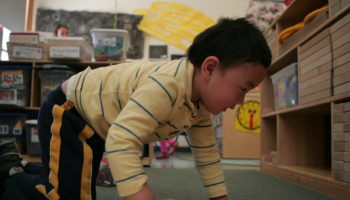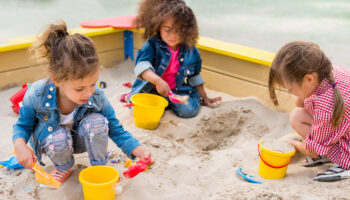Natalie Grebe
Its 9:00am in a preschool classroom. Two teachers have successfully orchestrated their class of 17 children to clean up their morning centers. One of the teachers calls out 9 names and asks those children to join her on the reading rug. The other teacher tells the remaining eight children to sit at their table seats for an activity. As the children get into their appropriate groups, they clumsily sit down, chatting and laughing, some poking their friends, others complaining they wanted to play longer. The teacher on the reading rug holds up a silver bell and rings it a few times. Almost immediately, many of the children quiet down and settle into their chairs or their space on the rug. A few continue to talk, but a gentle hand on their shoulder and one last ring of the bell tells them it is time to listen. For a moment, it is quiet and each teacher can use a soft voice to briefly tell their group what task they will be doing for the next few minutes.
The teacher leading the group on the rug shows the children a book she will read. She uses different voices for the characters and is sure all can see the pictures, but inevitably two of the children begin to lose interest and start to move around.
Meanwhile, the teacher leading the group at their tables has explained what materials the children can use to create their art project (open-ended, of course!). As the children busily choose their paper and markers, the teacher walks around the group encouraging them to begin their artwork. Inevitably, someone falls out of their chair. He’s okay, but a few of the children laugh, while others argue about who had the red marker first.
Each of these situations could easily escalate. Each teacher could choose to become frustrated and raise their voice to their group. Or, they could plan for these situations and have a few attention-getting props ready. Just as the bell sound alerted the children that it was time to settle down, other noisemakers can be effective too. Party horn-blowers and plastic kazoos are options. Clap a pattern and allow the children to clap the pattern back to you. These patterns can be simple for younger children, such as three claps, or add pauses and faster claps for older students.
While many children will respond to these sounds, others may remain more engaged with a puppet or similar prop. Traditionally, puppets are used to tell a story. While this is an excellent way to keep children’s attention, puppets can be used in other situations as well. For the group working at their table seats, once the project is explained, the teacher could bring out a puppet friend who will be “watching for children sitting nicely and adding lots of colors to their artwork”. The same puppet could comment on how quietly one child is working and later tell another child she cut out a terrific triangle. Stuffed animals and popular superhero figures are great props to use in this way as well.
For the teacher reading the story and talking to the children about a specific topic, there are other options. A magic wand can be waved in the air to spread a “quiet spell” over the group. For children who are reluctant to participate and answer questions, give them a pair of memory sunglasses (any sunglasses will do) to help them think of a response or comment. Teachers can also wear the sunglasses or a special hat, as it will help the students keep their focus directed to them.
On occasion, props may get children more excitable or you may find them fighting for a turn to use one. It is important to be consistent and have props be an everyday part of your routines. They will need to be varied. Get to know what your students respond to positively and be willing to let your guard down and be silly for a few moments. By alternating with sounds, objects, and items they can touch, you are sure to keep their attention on the task at hand for a few minutes longer.
For additional ideas, see these websites:
“Easy Ways To Engage Children During Storytime” https://www.kaplanco.com/ii/engage-children-during-storytime
“Using Props to Sing With Children” https://childhood101.com/using-props-to-sing-with-children/
“Using Songs and Props in Pre-K” https://www.prekinders.com/music-props/




